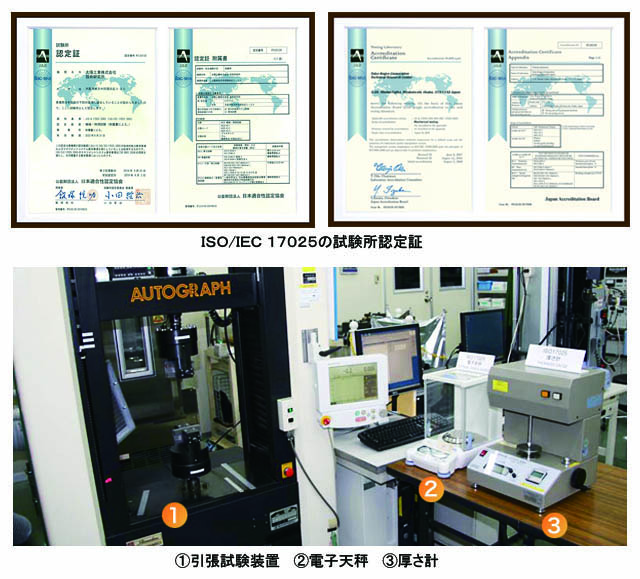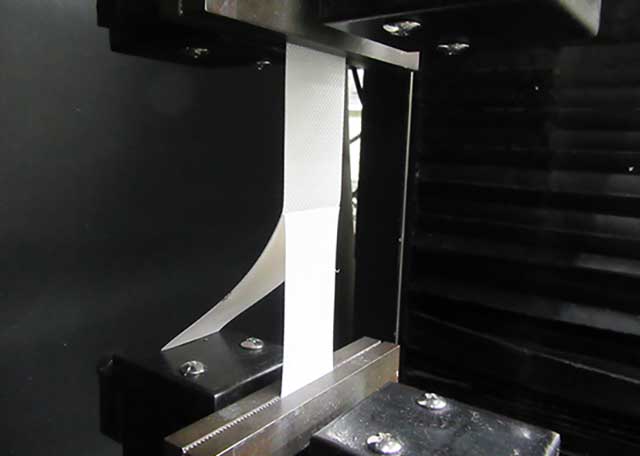Ltd. is the only manufacturer of membrane structures or membrane materials in the world*1 to be accredited as an ISO/IEC 17025 testing laboratory.
ISO/IEC 17025 is an international standard developed by the International Organization for Standardization for general requirements for the competence of testing and calibration laboratories. In addition to the requirements of ISO 9001, it is a more rigorous accreditation system that specifies elements such as traceability of personnel, facilities, environmental conditions, equipment, and measurements, as well as assurance of the quality of results. When a laboratory is accredited to this standard by an internationally accredited, mutually recognized accreditation body, its competence is officially recognized and the test report issued by the accredited laboratory can bear the accreditation symbol. These test reports are treated as equivalent to those issued by a national, third-party organization with guaranteed legitimacy and impartiality that is internationally accepted.
Since receiving laboratory accreditation from the Japan Accreditation Board for Conformity Assessment (JAB) in 2010, the Technical Research Institute has continued to maintain and expand its accreditation and laboratory activities each year.


We believe that improving the quality and reliability of our testing laboratories will greatly help us improve and enhance the quality and reliability of the products we handle, including construction, civil engineering, and logistics. The table below shows the scope of our testing.
In addition, in response to the recent revelations of several irregularities, regulations have been tightened through a review of the ministerial approval system for building materials. Specifically, as of April of this year, an on-site inspection of the manufacturing plant is required in principle when acquiring Ministerial Approval for building materials. However, if the performance of the material has been verified by a third-party organization, the on-site inspection is exempted.
In addition, continuous on-site inspections or performance verification of materials by a third-party organization are required every three years after certification is obtained. For membrane materials, this includes thickness, mass, tensile strength, etc.
In August of this year, a new mandatory item, “Adhesion Strength of Coating Layer,” was added. This “coating layer adhesion strength” is defined as “the strength at the time when the base fabric and coating layer are peeled off using a tensile tester after being peeled off in advance. Our laboratory is the only one in Japan and abroad that has acquired these four items.
Against this background, we believe that our ISO17025 accreditation will enable us to fulfill our role as a third-party organization and be of service to you in the future. Please feel free to contact us if you have any questions or concerns about our testing services.
*1: This is the only ISO 17025 laboratory certification as a membrane surface structure manufacturer and membrane material manufacturer, but this is based on our own research.
Table Titles and Scope of Tests Conducted at the Laboratory
| measurement item | Test Title | test range | unit |
| mass | Test Methods for Rubber and Plastic Draw Cloths
Part 1: Basic Properties (Standard Atmospheric and Draw Cloth Dimensions and Mass Measurement Methods) |
jis k 6404-1: 2015,. Test Method A: Total mass per unit area |
g/m2 |
| mass | Rubber- or plastics-coated fabrics – Determination of roll characteristics
Part 2: Methods for determination of total mass per unit area, mass per unit area of coating and mass per unit area of substrate |
ISO2286-2: 2016, bullet 3 | g/m2 |
| thickness | Test Methods for Rubber and Plastic Draw Cloths
Part 1: Basic Properties (Standard Atmospheric and Draw Cloth Dimensions and Mass Measurement Methods) |
jis k 6404-1: 2015 | mm |
| thickness | Rubber- or plastics-coated fabrics – Determination of roll characteristics
Part 3: Method for determination of thickness |
iso2286-3: 2016 | mm |
| Tensile Strength Elongation | Fabric testing methods for woven and knitted fabrics | A method; Strip method |
N
% |
| Tensile Strength Elongation | Fabric testing methods for woven and knitted fabrics | JIS L 1096: 2010, 8.14.2; ISO method, a) E method; strip method | N
% |
| Tensile Strength Elongation | Textiles – Tensile properties of fabrics
Part 1: Determination of maximum force and elongation at maximum force using the strip method |
iso 13934-1: 2013 | N
% |
| Tensile Strength Elongation | Rubber- or plastics-coated fabrics
Determination of tensile strength and elongation at break |
iso 1421: 2016,. Method 1 The strip test method |
N
% |
| Tensile Strength Elongation | Rubber- or plastics-coated fabrics
Determination of tensile strength and elongation at break |
BS EN ISO 1421: 2016,. Method 1 The strip test method |
N
% |
| Tensile Strength Elongation | Rubber- or plastics-coated fabrics
Determination of tensile strength and elongation at break |
NF EN ISO 1421: 1998,. Method 1 The strip test method |
N
% |
| Tensile Strength Elongation | Rubber- or plastics-coated fabrics
Determination of tensile strength and elongation at break |
Method 1 The strip test method |
N
% |
| Adhesion strength | Adhesion test of coating layer | (Japan Membrane Structures Association Test Method Standard
Quality and Performance Test Methods for Membrane Materials (MSAJ/M-03-2003) 12. adhesion strength of coated layer |
N/cm |
Phone: 072-856-9118
Click here to go to the contact page.





